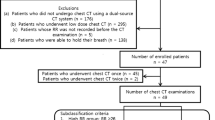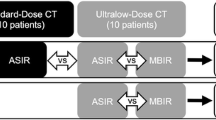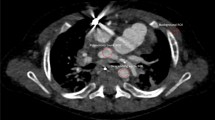Abstract
Background
Different iterative reconstruction techniques are available for use in pediatric computed tomography (CT), but these techniques have not been systematically evaluated in infants.
Objective
To determine the effect of iterative reconstruction on diagnostic performance, image quality and radiation dose in infants undergoing CT evaluation for congenital lung lesions.
Materials and methods
A retrospective review of contrast-enhanced chest CT in infants (<1 year) with congenital lung lesions was performed. CT examinations were reviewed to document the type of lung lesion, vascular anatomy, image noise measurements and image reconstruction method. CTDIvol was used to calculate size-specific dose estimates (SSDE). CT findings were correlated with intraoperative and histopathological findings. Analysis of variance and the Student’s t-test were used to compare image noise measurements and radiation dose estimates between groups.
Results
Fifteen CT examinations used filtered back projection (FBP; mean age: 84 days), 15 used adaptive statistical iterative reconstruction (ASiR; mean age: 93 days), and 11 used model-based iterative reconstruction (MBIR; mean age: 98 days). Compared to operative findings, 13/15 (87%), 14/15 (93%) and 11/11 (100%) lesions were correctly characterized using FBP, ASiR and MBIR, respectively. Arterial anatomy was correctly identified in 12/15 (80%) using FBP, 13/15 (87%) using ASiR and 11/11 (100%) using MBIR. Image noise was less for MBIR vs. ASiR (P < 0.0001). Mean SSDE was different among groups (P = 0.003; FBP = 7.35 mGy, ASiR = 1.89 mGy, MBIR = 1.49 mGy).
Conclusion
Congenital lung lesions can be adequately characterized in infants using iterative CT reconstruction techniques while maintaining image quality and lowering radiation dose.








Similar content being viewed by others
References
Epelman M, Kreiger PA, Servaes S et al (2010) Current imaging of prenatally diagnosed congenital lung lesions. Semin Ultrasound CT MR 31:141–157
Quinn TM, Hubbard AM, Adzick NS (1998) Prenatal magnetic resonance imaging enhances fetal diagnosis. J Pediatr Surg 33:553–558
Mettler FA Jr, Bhargavan M, Faulkner K et al (2009) Radiologic and nuclear medicine studies in the United States and worldwide: frequency, radiation dose, and comparison with other radiation sources—1950–2007. Radiology 253:520–531
Larson DB, Johnson LW, Schnell BM et al (2011) Rising use of CT in child visits to the emergency department in the United States, 1995–2008. Radiology 259:793–801
Hoshiko S, Smith D, Fan C et al (2014) Trends in CT scan rates in children and pregnant women: teaching, private, public and non-profit facilities. Pediatr Radiol 44:522–528
Brenner DJ, Hall EJ (2007) Computed tomography—an increasing source of radiation exposure. N Engl J Med 357:2277–2284
Smith EA, Dillman JR, Goodsitt MM et al (2014) Model-based iterative reconstruction: effect on patient radiation dose and image quality in pediatric body CT. Radiology 270:526–534
Koc G, Courtier JL, Phelps A et al (2014) Computed tomography depiction of small pediatric vessels with model-based iterative reconstruction. Pediatr Radiol 44:787–794
Boone J, Strauss K, Cody D et al. (2011) Size-specific dose estimates (SSDE) in pediatric and adult body CT examinations. Report of AAPM Task Group #204. American Association of Physicists in Medicine, College Park
Deak PD, Smal Y, Kalender WA (2010) Multisection CT protocols: sex- and age-specific conversion factors used to determine effective dose from dose-length product. Radiology 257:158–166
Prakash P, Kalra MK, Kambadakone AK et al (2010) Reducing abdominal CT radiation dose with adaptive statistical iterative reconstruction technique. Invest Radiol 45:202–210
Singh S, Kalra MK, Hsieh J et al (2010) Abdominal CT: comparison of adaptive statistical iterative and filtered back projection reconstruction techniques. Radiology 257:373–383
Kaza RK, Platt JF, Goodsitt MM et al (2014) Emerging techniques for dose optimization in abdominal CT. Radiographics 34:4–17
Gonzalez-Guindalini FD, Ferreira Botelho MP, Töre HG et al (2013) MDCT of chest, abdomen, and pelvis using attenuation-based automated tube voltage selection in combination with iterative reconstruction: an intrapatient study of radiation dose and image quality. AJR Am J Roentgenol 201:1075–1082
Ichikawa Y, Kitagawa K, Nagasawa N et al (2013) CT of the chest with model-based, fully iterative reconstruction: comparison with adaptive statistical iterative reconstruction. BMC Med Imaging 9:13–27
Yanagawa M, Gyobu T, Leung AN et al (2014) Ultra-low-dose CT of the lung: effect of iterative reconstruction techniques on image quality. Acad Radiol 21:695–703
Katsura M, Matsuda I, Akahane M et al (2013) Model-based iterative reconstruction technique for ultralow-dose chest CT: comparison of pulmonary nodule detectability with the adaptive statistical iterative reconstruction technique. Invest Radiol 48:206–212
Miéville FA, Berteloot L, Grandjean A et al (2013) Model-based iterative reconstruction in pediatric chest CT: assessment of image quality in a prospective study of children with cystic fibrosis. Pediatr Radiol 43:558–567
Conflicts of interest
None
Author information
Authors and Affiliations
Corresponding author
Rights and permissions
About this article
Cite this article
Haggerty, J.E., Smith, E.A., Kunisaki, S.M. et al. CT imaging of congenital lung lesions: effect of iterative reconstruction on diagnostic performance and radiation dose. Pediatr Radiol 45, 989–997 (2015). https://doi.org/10.1007/s00247-015-3281-4
Received:
Revised:
Accepted:
Published:
Issue Date:
DOI: https://doi.org/10.1007/s00247-015-3281-4




